Three Found Guilty in August 2006 UK Liquid Explosives Plot
News & Happenings
"...the men planned to inflict heavy casualties, 'all in the name of Islam'. 'These men were, we say, indifferent to the carnage that was likely to ensue. Some of the men you see in the dock are those who were prepared to sacrifice their own lives.'"
Peter Wright, QC
Prosecutor of the eight UK plot suspects.
September 8, 2008
The verdict is in for the 2006 trans-Atlantic liquid explosives terror trial in the United Kingdom. Three of the eight men on trial, Abdulla Ahmed Ali, Assad Sarwar and Tanvir Hussain, were found guilty of conspiracy to murder.
One of the defendants was acquitted of all charges, and the jury was unable to reach a verdict on the remaining four.
During the six-month trial, the jury heard evidence from prosecutors that the eight men were planning to carry liquid explosives on to planes at London's Heathrow airport destined for the United States and Canada, knowing the devices would evade airport security protocols.
To read more about the trial, click here and here.
August 6, 2008
The jury in the London Bomb plot trial is in its 10th day of deliberation.
The judge reassured the jury members early in the deliberation phase that there is no time pressure and they can take as long as needed to consider the case.
The trial judge warned jurors to discount all outside influences. He urged them to ignore the repercussions of their verdicts, either on the defendants and their families or from the media and public, and to focus solely on the issue of whether there was a conspiracy to commit murder. They must not let their decisions be tainted by whether any conspiracy would have been successful or by their personal opinions about British and US foreign policy.
All eight men on trial deny two charges of conspiracy to murder, but three of the eight defendants have pleaded guilty to conspiracy to cause explosions. Seven of the eight have also admitted to conspiring to cause a public nuisance by making videos threatening bombings; however one defendant has claimed that the recorded martyrdom videos were created as a hoax to be used in an internet documentary.
July 14, 2008
This week, three of the men accused in the planning of the UK bomb plot pled guilty to conspiring to cause explosions. The men admitted they planned to set off bombs in Parliament and one said the bombs would be used on passenger airplanes. In addition, they and two more defendants also admitted to publishing videos threatening bombings.
To read the full BBC article click here.
June 16, 2008
On June 11, 2008 Assad Sarwar, a British Muslim accused of planning the 2006 liquids plot, told a court he carried out research on the internet to identify Birmingham International Airport as a possible target. He admitted to purchasing and hiding materials to manufacture an explosive device designed to have the "hallmark of an al Qaida attack."
Click here to read the full article.
June 9, 2008
The trial continues with the questioning of the supposed ringleader of the transatlantic terror plot, defendant Abdulla Ahmed Ali, 27.
Prosecutor Peter Wright QC questioned Mr. Ali about contradictions that have emerged in the case since the suspected men involved were arrested in August 2006.
To read the full article, click here.
June 4, 2008
Briton Admits to Plot to Set Off Explosives at Heathrow Airport
LONDON - A British man accused of leading a plot to blow up as many as seven trans-Atlantic airliners on a single day in 2006 said in a London court on Tuesday that he had planned to set off one or two explosive devices at Heathrow Airport, but that he had never intended to place them on aircraft.
The man, Abdulla Ahmed Ali, is one of eight Muslim men on trial on charges of planning suicide attacks on airliners using bombs mixed from household chemicals carried on board. Mr. Ali said the plan had been to "create a disturbance" outside one of the American airlines' offices at Heathrow's Terminal 3 that would attract "a lot of attention" to Muslim militants' opposition to British and American policy in Iraq and Afghanistan and to a video documentary his group planned to place on YouTube.
The defendants are charged with conspiracy to murder and conspiracy to "commit an act of violence likely to endanger the safety of an aircraft." All have denied the accusations. The trial is expected to last eight months.
Click here to read the entire story from the New York Times.
May 17, 2008
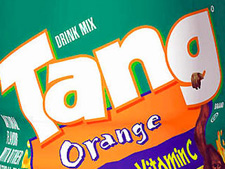
Fox News published a story on the UK trial, noting that liquid explosives are the new weapons of choice.
"The alleged plot, and the excellent police work that went into busting it, resulted in the tough carry-on restrictions passengers face before boarding an airplane. Knowing the dangers of liquid explosives should make the hassle of tossing your bottles when traveling a lot easier to bear."
Click here to read the entire article: Tang Bomb: Liquid Explosives are the new 'Weapon of Choice'
May 13, 2008
This week, UK plot terror trial jurors were shown a video of the liquid explosive the suspected terrorists allegedly planned to use on airplanes headed for the United States and Canada. The liquid explosive mix was created in a government laboratory and placed in an Oasis soft drink bottle, just as the terrorists planned to do.
Jurors were also shown the hollowed out battery that would hide the detonator for the device.
For more details and to watch the video shown in court, click here.
To see a video made in the United States that demonstrates the capabilities of the UK explosive, click here.
May 7, 2008
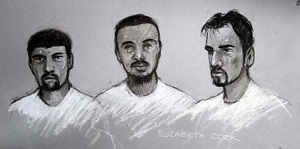
Artist's impression of (left to right) Arafat Waheed
Khan, Umar Islam and Ahmed Abdullah Ali, three of
the men allegedly involved in a plot to blow up
airliners.
The jury at London's Woolwich Crown Court has now heard recordings of alleged conversations between the suspected terrorists. The recordings were made after British security services bugged the apartment the men were using as their "bomb factory."
Voices were heard making reference to popular British holiday destinations in the United States, including Miami and the beaches of California. There was mention made of the drink mix Tang and dissolving it so that it was clear and not misty, as well as discussion to test things. Batteries were repeatedly referenced and an apparent drilling sound was picked up by the recording device.
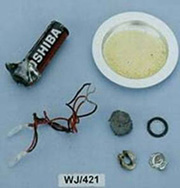
The eight men continue to deny the two charges against them: Conspiracy to murder between January 1 and August 11, 2006 and conspiracy to commit an act of violence likely to endanger the safety of an aircraft between the same dates.
For more information:
Airliner bomb suspects 'bugged' (BBC)
The UK Liquid Explosives Plot (HSToday)
Click here for photos from the trial.
April 18 Update
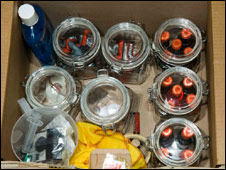
On 31 July 2006, just days before the men were arrested, British officers found two plastic bags in a park in east London. The bags contained wires attached to miniature bulbs, with exposed filaments designed to spark liquid bombs. Experts have found DNA and fingerprints linking defendant Tanvir Hussain to the two bags.
Additional details on the contents of the suitcase found in the woods near one suspect's home have been released. The suitcase found is now said to have contained everything needed to make the high explosive HMTD, including: hydrogen peroxide, citric acid, hexamine, thermometers, syringes, pipettes and glass flasks. One glass jar inside the suitcase had a fingerprint on it that resembles that of defendant Assad Sarwar, one of the ringleaders of the alleged plot.
In another nearby wooded area, search teams discovered 20 liters of hydrogen peroxide in 5 liter containers hidden in black garbage bags.
Additional items have been found in the London flat used as the alleged "bomb factory," including: drink bottles with holes in the bottoms and DNA of defendants Abdulla Ahmed Ali and Tanvir Hussain, the drink mix Tang, electronic scales, black wire, pieces of foam, jars full of batteries, tape, food coloring, a stained metal spoon, a volt reader, a ph reader and a pocket knife.
Members of the jury at Woolwich Crown Court have heard the six recorded "martyrdom videos." The videos were allegedly found at the home of one defendant.
- Abdula Ahmed Ali calls the alleged plot a "blessed operation."
- Umar Islam says, "This is revenge for [our] actions."
- Ibrahim Savant urges other Muslims to "enter the battlefield."
- Waheed Zaman claims that he is "not brainwashed" and is "old enough to make [his] own decisions."
- Tanvir Hussain believes that "collateral damage" is inevitable but worth the price.
- Arafat Waheed Khan asserts that an even greater "torment awaits [us] in the hereafter."
Additional Resources
- Full written transcripts of the videos
- A brief series of picture evidence
- Bomb equipment 'left in park bin'
- July 7 accused visited Pakistan before attack
We will continue to update this site as new details emerge.
Main Information
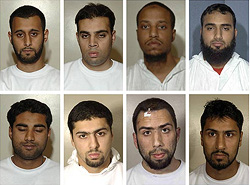
Terror suspects ... top row left to right
Tanvir Hussain, Assad Sarwar, Umar Islam,
aka Brian Young, Waheed Zaman, bottom
row Mohammed Gulzar, Arafat Waheed
Khan, Ibrahim Savant and Abdul Ali,
aka Ahmed Ali Khan.
On August 10, 2006, a plot to use liquid explosives to blow up transatlantic flights headed to the United States and Canada was foiled by UK authorities. In light of the threat, the US and UK immediately banned liquids from going through checkpoints and onto airplanes. US Federal Air Marshals were dispatched to cover all affected flights immediately following this plot.
In September 2006, after international and US explosives experts determined that acceptable amounts of liquids could safely be brought on planes, TSA implemented the 3-1-1 program.
In the UK, the trial began on April 3 for eight British men, many of Pakistani descent, suspected of being involved in a British terror cell with plans to commit a massive transatlantic terrorist attack on August 10, 2006.
Here's A Recap
The eight men were arrested by British authorities in August 2006, allegedly close to the execution date of their plot. The plot included bringing liquid explosives disguised as commonly consumed UK beverages onto seven planes from London's Heathrow Airport to various cities in the United States and Canada. The liquid explosives would have detonated while flying over the Atlantic Ocean.
All seven targeted flights were scheduled to depart London within a time period of two hours and 35 minutes, offering little hope of saving the already airborne planes once the first explosive was detonated. Having the planes explode over the ocean would have made recovery and investigation very difficult. Had the plan been successful, it is estimated that as many as 1,500 passengers would have been killed.
New Information From The Trial
Since the trial began, the following information has been presented to the jury:

- The group purchased a flat in north-east London in July 2006 for £138,000 ($275,558 US dollars at today's exchange rate.) in cash and transformed it into an alleged "bomb factory."
- Searches of the property produced many components with the ability to create liquid improvised explosive devices that could be assembled and detonated on an aircraft.
- The woods near one suspect's home contained a suitcase filled with syringes and chemicals.
- The main ingredient of the explosives mixture was hydrogen peroxide mixed with other organic materials.
- The terrorists would inject the liquid explosive into sealed 500 milliliter plastic bottles of soft drinks "Oasis" and "Lucozade" prior to boarding the plane.
- Tang, a sugary drink, would be mixed with the hydrogen peroxide solution for a more powerful explosion.
- The liquid explosives would be detonated using a substance called HMTD (hexamethylene triperoxide diamine) concealed in AA 1.5-volt batteries.
- Pages from one of the suspect's (Mr. Ali) handwritten diary make apparent references to how the bomb materials would have been taken onto the aircraft.
- The bombers would have used a syringe to insert the explosive material into the base of the bottles, without breaking the seal on the cap.
- The detonator would have been ignited using a metal wire, a small bulb or the flash from a disposable camera.
- Pornographic magazines were to be placed in carry-on luggage to distract security personnel and indicate that the men were not religious zealots.
- Each man intended to carry two bottled explosives through security in case one of them was taken away.
- The allegedly targeted flights included aircraft bound for Montreal, Toronto, San Francisco, Chicago, New York, and Washington, DC.
Video Clips of the Trial
- BBC News: 7/7 'inspired airline plotters'
- The Sun: 'Bombers' made martyr videos
- CTV.ca: Canadian jets targeted in U.K. terror plot, trial hears
Targeted Flights
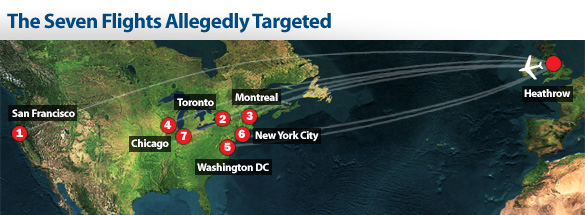
- 14:15 United Airlines Flight 931 to San Francisco
- 15:00 Air Canada Flight 849 to Toronto
- 15:15 Air Canada Flight 865 to Montreal
- 15:40 United Airlines Flight 959 to Chicago
- 16:20 United Airlines Flight 925 to Washington
- 16:35 American Airlines Flight 131 to New York
- 16:50 American Airlines Flight 91 to Chicago
This page will be updated with more information as the trial continues.


